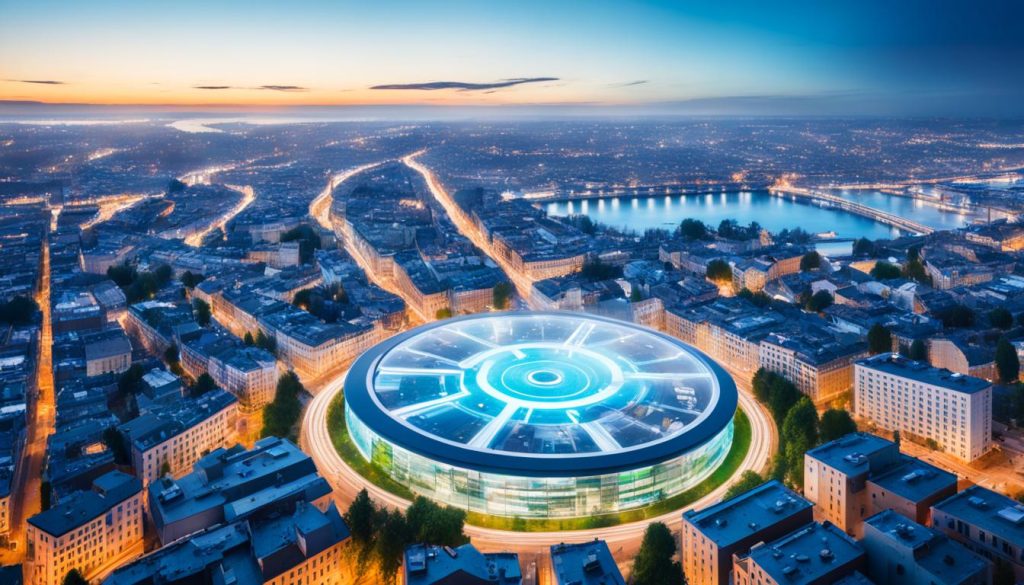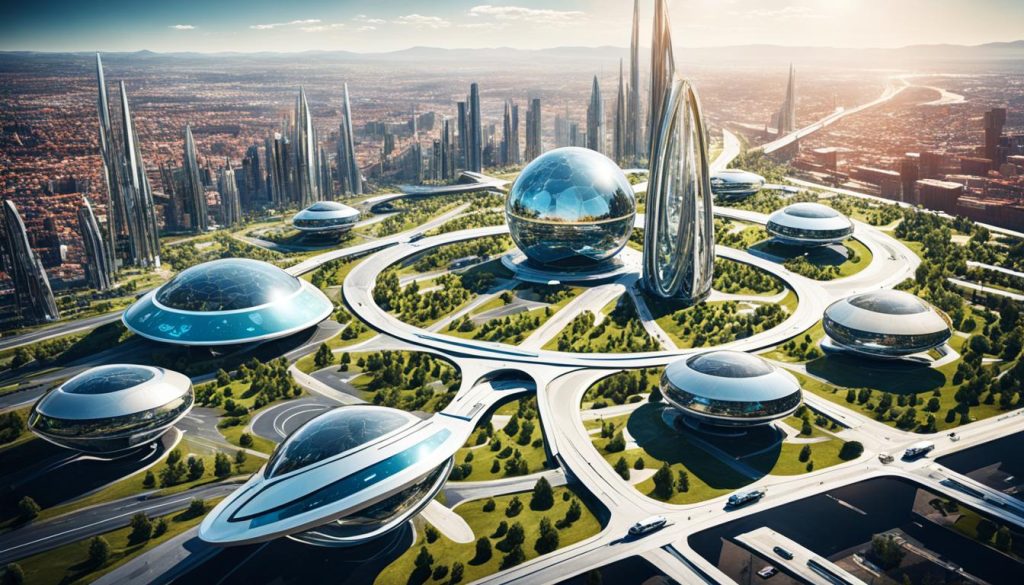Cities around the world are experiencing rapid growth, with the urban population projected to reach 68% by 2050. As urban areas continue to expand, there is an increasing need to effectively utilize urban resources to ensure sustainable development and efficient resource management. The United Nations predicts that by 2030, there will be 43 megacities worldwide with populations of at least 10 million. However, this rapid urbanization also leads to resource depletion and the degradation of urban ecosystems. It is estimated that urban areas consume more than 70% of total natural resources, and addressing this issue is crucial for achieving urban sustainability.
Key Takeaways:
- Utilizing urban resources efficiently is essential for sustainable urban development.
- Rapid urbanization leads to resource depletion and the degradation of urban ecosystems.
- Urban areas consume more than 70% of total natural resources.
- Addressing resource efficiency is crucial for achieving urban sustainability.
- Efficient urban resource management is necessary to optimize land use and preserve ecosystems.
The Challenges of Urbanization and Resource Depletion
The rapid pace of urbanization has brought about numerous challenges, including resource depletion and environmental degradation. As urban areas continue to expand, the demand for resources such as water, energy, and raw materials has increased exponentially.
One of the major challenges is the issue of water shortage, especially in densely populated cities. For instance, many cities in China are grappling with severe water scarcity due to high population density and increased water consumption. Jakarta, Indonesia is facing a resource crisis caused by population growth, traffic congestion, water pollution, and the impacts of climate change. In addition, developing countries like Bangladesh are experiencing significant changes in land cover and land use due to population densification.
It is crucial to address the issues of urban sprawl and growth in order to ensure sustainable resource management. The consequences of unchecked urbanization, such as water shortage and land cover change, can have long-lasting impacts on both the environment and the well-being of urban populations.
By addressing the challenges of urbanization and resource depletion, we can mitigate environmental degradation and create more sustainable and resilient cities. This requires a comprehensive approach that involves efficient resource management, sustainable urban planning, and the adoption of green infrastructure solutions.
| Challenges | Cities |
|---|---|
| Water shortage | China, Jakarta |
| Resource crisis | Jakarta |
| Land cover change | Bangladesh |
The Role of Urban Resource Management
Urban resource management plays a crucial role in achieving sustainable development in cities. It involves the conscious handling of natural resources such as energy and materials, as well as the utilization of infrastructure and technology to meet human needs.
The concept of a “resource efficient city” focuses on minimizing the extraction of raw materials, waste production, and energy consumption while preserving ecosystems and ecosystem services. Effective urban resource management is essential for optimizing land use, disaster management, and infrastructure development, leading to more efficient and sustainable cities.

By implementing strategies and techniques that promote efficient resource utilization, urban resource management contributes to the overall sustainability of cities. It helps address pressing environmental concerns, such as climate change and the depletion of natural resources.
Minimizing Resource Extraction and Waste
A key aspect of urban resource management is the minimization of resource extraction and waste production. By implementing recycling programs and promoting circular economy practices, cities can reduce the demand for raw materials and minimize waste generation. Additionally, efficient use of resources through technologies like energy-efficient systems and smart infrastructure can significantly reduce energy consumption and decrease the ecological footprint of urban areas.
Preserving Ecosystems and Ecosystem Services
Urban resource management also focuses on preserving ecosystems and the valuable services they provide. By incorporating green infrastructure solutions, such as parks, urban forests, and wetlands, cities can enhance biodiversity, mitigate urban heat islands, and improve air and water quality. These green spaces not only provide recreational opportunities but also contribute to the overall well-being and resilience of urban communities.
Optimizing Land Use and Infrastructure Development
Efficient resource management enables cities to optimize land use and infrastructure development. Through strategic urban planning, cities can prioritize compact and mixed-use developments, reducing the need for extensive land consumption and minimizing sprawl. Additionally, integrating sustainable transportation systems, such as public transit and active transportation options, allows for more efficient movement of people and goods while reducing congestion and greenhouse gas emissions.
By effectively managing urban resources, cities can create a more sustainable and resilient future, ensuring the well-being of both current and future generations.
Leveraging Space Exploration for Urban Efficiency
Space exploration has brought about remarkable technological advancements that can greatly enhance urban efficiency. Satellites equipped with remote sensing technologies provide invaluable data for urban planning and decision-making. Climate monitoring systems enable cities to prepare for extreme weather events and develop strategies to mitigate their impact. GPS technology, derived from space exploration, has revolutionized urban transportation and logistics. Solar energy, originally developed for space missions, is now widely utilized in urban areas, reducing reliance on fossil fuels. By harnessing these space-derived technologies, cities can optimize planning, improve transportation systems, and promote sustainability.
The Benefits of Space-derived Technologies
Space-derived technologies have revolutionized urban areas, offering numerous benefits that contribute to improved planning, disaster preparedness, sustainable energy solutions, smart transportation, and environmental monitoring.
Improved Planning
Satellite imagery and remote sensing data provide valuable insights into land use and resource management, enabling urban planners to make informed decisions. By analyzing satellite data, cities can identify suitable areas for development, optimize urban growth, and ensure efficient utilization of resources.
Disaster Preparedness
Climate monitoring systems derived from space exploration provide cities with crucial information about weather patterns and potential natural disasters. By forecasting and monitoring extreme weather events, cities can develop effective disaster response plans, minimize damage, and mitigate the impact on residents.
Sustainable Energy Solutions
Solar energy, originally developed for space missions, is now widely used in urban areas. By harnessing the power of the sun, cities can reduce reliance on fossil fuels, lower carbon emissions, and promote sustainable development. Solar energy solutions contribute to cleaner and more environmentally friendly urban environments.
Smart Transportation
GPS technology, derived from space exploration, has revolutionized transportation systems in urban areas. By integrating GPS technology into vehicles and transportation networks, cities can optimize routes, reduce congestion, and improve overall transportation efficiency. Smart transportation solutions enhance mobility and reduce the environmental impact of urban commuting.
Environmental Monitoring
Space-based sensors and satellites play a vital role in environmental monitoring and sustainable urban design. These technologies provide valuable data on air quality, water pollution, and ecosystem health. By monitoring and analyzing this data, cities can implement targeted environmental strategies, preserve natural resources, and create healthier urban environments.
| Benefits | Description |
|---|---|
| Improved Planning | Satellite imagery and remote sensing data inform urban planning decisions, optimizing land use and resource management. |
| Disaster Preparedness | Climate monitoring systems derived from space exploration help cities prepare for and respond to natural disasters. |
| Sustainable Energy Solutions | Solar energy solutions reduce reliance on fossil fuels, promote sustainability, and lower carbon emissions. |
| Smart Transportation | GPS technology enhances transportation efficiency, optimizing routes and reducing congestion in urban areas. |
| Environmental Monitoring | Space-based sensors and satellites provide valuable data for environmental monitoring and sustainable urban design. |

Data-driven Urban Planning and Sustainability
Data plays a crucial role in optimizing urban efficiency and sustainability. By harnessing the power of data, urban planners can make informed decisions to create more efficient and sustainable cities. Whether it’s understanding population densities, combating urban heat islands, analyzing traffic patterns, or monitoring environmental conditions, data-driven approaches provide valuable insights for urban development.
Population Densities:
Accurate information about population densities is essential for effective urban planning. Satellite imagery provides detailed data on population distribution, enabling urban planners to identify areas with high population densities and plan housing and infrastructure accordingly. This data-driven approach helps ensure that cities can accommodate the needs of their growing populations without compromising on sustainability and livability.
Urban Heat Islands:
Urban heat islands, characterized by higher temperatures in urban areas compared to surrounding rural areas, pose a significant challenge for cities. Remote sensing data can help identify and understand the factors contributing to urban heat islands, such as building density, materials, and vegetation cover. With this information, urban planners can design targeted interventions, such as green spaces and cool roofs, to mitigate the impact of urban heat islands and create more comfortable and sustainable urban environments.
Traffic Analysis:
Traffic congestion is a common issue in urban areas, leading to increased fuel consumption, air pollution, and travel times. By utilizing satellite data and real-time traffic information, traffic management systems can optimize traffic flow, reduce congestion, and improve transportation efficiency. Data-driven traffic analysis enables the implementation of intelligent transportation systems, such as adaptive traffic signals, dynamic lane management, and real-time navigation, making urban mobility more sustainable and convenient for residents and visitors alike.
Environmental Monitoring:
Monitoring and managing the environment in urban areas is crucial for sustainable development. Space-based sensors provide valuable data for environmental monitoring, including air quality, water quality, and green spaces. By analyzing this data, urban planners can identify areas with environmental challenges and implement targeted solutions to improve the overall environmental quality of the city. This data-driven approach ensures that cities can protect natural resources, preserve biodiversity, and create a healthier and more sustainable living environment.
Data-driven urban planning and sustainability are integral parts of creating efficient, resilient, and livable cities. By leveraging the power of data, urban planners can make informed decisions, optimize resource allocation, and create a better future for urban communities.
The Future of Urban Efficiency and Space Exploration
The future of urban efficiency holds immense potential with advancements in space exploration. Innovations in advanced satellite systems will offer enhanced precision in urban planning and decision-making processes.
Autonomous systems, such as self-driving vehicles and smart infrastructure, will revolutionize urban transportation, leading to increased efficiency and reduced congestion. These autonomous systems can optimize route planning, minimize travel time, and lower carbon emissions.
Furthermore, integrated urban solutions that combine space-derived technologies with Internet of Things (IoT) devices will unlock new possibilities for resource management, energy efficiency, and overall urban development. The integration of advanced satellite systems and IoT devices will enable real-time data collection and analysis, empowering cities to make informed decisions for sustainable growth.
One example of integrated urban solutions is the creation of smart grids that utilize real-time data from advanced satellite systems to optimize energy distribution, reduce energy wastage, and enhance overall grid efficiency.
By harnessing the power of advanced satellite systems, autonomous systems, and integrated urban solutions, cities can achieve higher levels of resource optimization, energy efficiency, and environmental sustainability.
This progress in space exploration continues to shape and improve urban efficiency, enabling cities to explore new frontiers and overcome existing challenges. As cities continue to grow, the integration of space-derived technologies will play a pivotal role in building smarter and more sustainable urban environments.
Advancements in Advanced Satellite Systems
Advanced satellite systems are paving the way for more accurate and comprehensive data collection, enabling cities to make informed decisions for urban efficiency. These systems offer:
- High-resolution imagery for precise land use analysis
- Real-time monitoring of urban infrastructure and environmental conditions
- Improved disaster preparedness and response through early warning systems
The Revolution of Autonomous Systems
Autonomous systems are set to transform urban transportation and efficiency, offering numerous benefits:
- Reduction in traffic congestion and improved traffic flow
- Enhanced safety through accident prevention and mitigation
- Optimized route planning and reduced travel time
Integrated Urban Solutions for Resource Management
The integration of space-derived technologies with IoT devices enables cities to optimize resource management and energy efficiency:
- Real-time monitoring of water and energy consumption for efficient resource allocation
- Smart grids for optimized energy distribution
- Intelligent waste management systems for reducing environmental impact
Future Outlook
The future holds immense opportunities for urban efficiency, driven by advancements in space exploration. As cities embrace advanced satellite systems, autonomous systems, and integrated urban solutions, they can unlock their full potential for sustainable growth, resource optimization, and enhanced quality of life.

Connecting Two Frontiers: Utility Tunnels and Urban Efficiency
Utility tunnels are a game-changing solution for optimizing urban infrastructure and improving efficiency. These underground passageways provide a host of benefits, including efficient space utilization, enhanced safety, and minimized environmental impact.
Utility tunnels serve as conduits for essential services such as electrical cables, water pipes, and telecommunications lines. By relocating these utilities underground, valuable above-ground space is freed up for other purposes, such as parks, pedestrian walkways, or additional infrastructure. This efficient space utilization allows cities to maximize their potential and meet the growing demands of urbanization.
Besides efficient space utilization, utility tunnels also offer enhanced safety and reliability. By protecting infrastructure from natural disasters and human disruptions, such as construction activities or accidental damage, utility tunnels ensure uninterrupted service and minimize downtime. This enhanced safety is crucial for maintaining a well-functioning city and providing essential services to its residents.
Moreover, utility tunnels contribute to a minimized environmental impact. By relocating utilities underground, visual pollution is reduced, preserving the aesthetic appeal of urban areas. Additionally, these tunnels minimize energy loss during transmission, resulting in more efficient and sustainable resource utilization.
Utility tunnels are a testament to innovative urban planning and infrastructure development, enabling cities to optimize their resources, enhance safety, and protect the environment. By embracing this revolutionary solution, cities can pave the way for a more efficient, sustainable, and resilient future.
| Benefits of Utility Tunnels |
|---|
| Efficient space utilization |
| Enhanced safety and reliability |
| Minimized environmental impact |
Urban Infrastructure Optimization
- Utility tunnels free up valuable above-ground space for urban development.
- These tunnels allow cities to meet the growing demands of urbanization.
- Improved space utilization contributes to efficient resource management.
Enhanced Safety and Reliability
- Utility tunnels protect infrastructure from natural disasters and human disruptions.
- Uninterrupted service ensures the well-being of urban residents.
- Reliable infrastructure supports critical services and emergency response.
Minimized Environmental Impact
- Utility tunnels reduce visual pollution and preserve the aesthetic appeal of urban areas.
- Energy loss during transmission is minimized, promoting sustainability.
- Optimized resource utilization helps minimize the environmental footprint of cities.
Connecting Urban Efficiency with Space Exploration through Utility Tunnels
Utility tunnels not only optimize urban efficiency but also have the potential to bridge the gap between urban environments and space exploration. These tunnels can provide the necessary infrastructure for future human settlements on the Moon, Mars, and other celestial bodies, supporting resource utilization and exploration. By utilizing utility tunnels, we can facilitate efficient transportation and communication networks in extraterrestrial environments.
Enabling Lunar and Martian Colonies
Utility tunnels offer a solution for establishing infrastructure in lunar and Martian colonies. These tunnels can house habitats, power systems, and essential utility services, providing a safe and protected environment for future settlers. By leveraging the advantages of utility tunnel technology, we can address the challenges of building sustainable and functional colonies on celestial bodies.
Enhancing Resource Utilization and Exploration
With utility tunnels, we can optimize resource utilization and exploration in space. These tunnels can be used to extract and transport valuable resources from lunar and Martian surfaces, supporting ongoing research and enabling long-term missions. By efficiently accessing and utilizing resources, we can advance our understanding of the universe and pave the way for future space exploration endeavors.
Facilitating Communication and Transportation Networks
Communication and transportation networks are essential for the success of space exploration missions. Utility tunnels can serve as conduits for establishing reliable communication systems and efficient transportation routes in extraterrestrial environments. By connecting different areas and enabling seamless communication and travel, utility tunnels contribute to the development of robust and interconnected space infrastructure.
Through the integration of utility tunnels into space exploration, we can connect the realms of urban efficiency and interplanetary exploration. By leveraging the potential of these tunnels, we can establish sustainable colonies on celestial bodies, optimize resource utilization, and create efficient communication and transportation networks in the vast expanse of space.
The Power of Collaboration: Healthy-Polis Initiative
The Healthy-Polis initiative brings together researchers, practitioners, and organizations from around the world to address the critical intersection of public health and urban environments in the context of climate change. By leveraging global resources and expertise, Healthy-Polis aims to identify and tackle the health impacts of urbanization and climate change, working towards healthier and more sustainable cities.
The initiative focuses on research collaboration to develop evidence-based policies and interventions that promote public health in urban areas. By fostering partnerships and sharing knowledge, Healthy-Polis strives to create a collaborative network that drives meaningful change and improves the well-being of urban populations.
Key Objectives
- Investigate the health impacts of urbanization and climate change
- Identify strategies for mitigating and adapting to climate change in urban environments
- Develop evidence-based policies to improve public health in cities
- Promote sustainable urban planning and design
- Enhance research collaboration and facilitate knowledge sharing
Collaboration is at the core of the Healthy-Polis initiative, recognizing that addressing complex challenges requires diverse perspectives and expertise. By fostering research collaboration between academia, government agencies, non-profit organizations, and the private sector, Healthy-Polis aims to drive innovation, facilitate knowledge exchange, and develop practical solutions to improve public health in urban environments.
Research Areas
The research conducted under the Healthy-Polis initiative covers a wide range of topics related to public health in urban environments. Some key research areas include:
- Assessing the impact of urban air pollution on respiratory health
- Investigating the relationship between urban green spaces and mental well-being
- Examining the effects of heatwaves on vulnerable populations in urban areas
- Evaluating the effectiveness of urban transportation systems in promoting physical activity
- Studying the health implications of urban noise pollution
Through collaborative research and data-driven approaches, the Healthy-Polis initiative aims to generate valuable insights that can inform policy decision-making and support evidence-based interventions for healthier and more sustainable cities.
Partnerships and Impact
The Healthy-Polis initiative has formed partnerships with leading academic institutions, research centers, and public health organizations worldwide. These collaborations enable the exchange of knowledge, resources, and best practices, fostering a global community focused on addressing public health challenges in urban environments.
By promoting research collaboration, Healthy-Polis aims to translate scientific findings into practical solutions and policy recommendations. The initiative seeks to influence decision-makers at local, national, and international levels to prioritize public health in urban planning, design, and policymaking, ultimately creating healthier and more sustainable cities for future generations.
| Organization | Location |
|---|---|
| World Health Organization (WHO) | Geneva, Switzerland |
| Centers for Disease Control and Prevention (CDC) | Atlanta, United States |
| University of California, Berkeley | Berkeley, United States |
| London School of Hygiene & Tropical Medicine | London, United Kingdom |
| Columbia University Mailman School of Public Health | New York, United States |
The Healthy-Polis initiative’s collaborations with these esteemed organizations drive impactful research, policy development, and practical solutions that contribute to the creation of healthier, more sustainable cities worldwide.
Conclusion
Maximizing benefits from urban resources efficiently is crucial for achieving urban sustainability and addressing the challenges of rapid urbanization. By leveraging space exploration and space-derived technologies, we can optimize resource management, improve transportation systems, and promote sustainable energy solutions in cities. The integration of utility tunnels into urban infrastructure offers innovative ways to enhance urban efficiency and bridge the gap between urban environments and space exploration.
In order to tackle the complex issues at the intersection of urban sustainability, resource efficiency, and space exploration, collaboration among researchers, practitioners, and organizations is vital. By working together, we can develop effective strategies and solutions that create efficient, sustainable, and resilient cities for future generations.
Urban sustainability relies on our ability to optimize resource utilization, reduce our environmental impact, and ensure the well-being of communities. As we continue to explore and leverage the advancements in space exploration, we can find new ways to address the challenges of urbanization and resource depletion. By embracing collaboration and innovative solutions such as utility tunnels, we can create a brighter future for our cities and pave the way for sustainable urban development.
